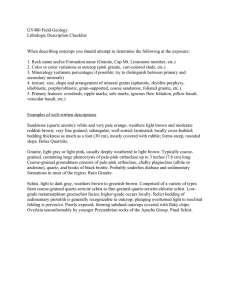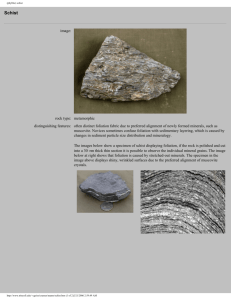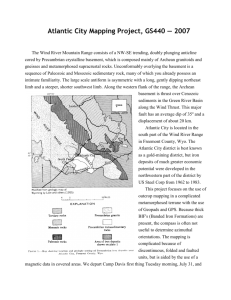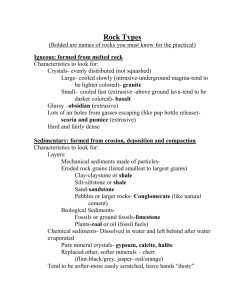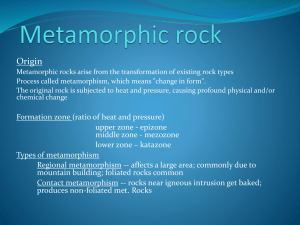A Study and Methodological Analysis of Neolithic Architecture in David Koppang
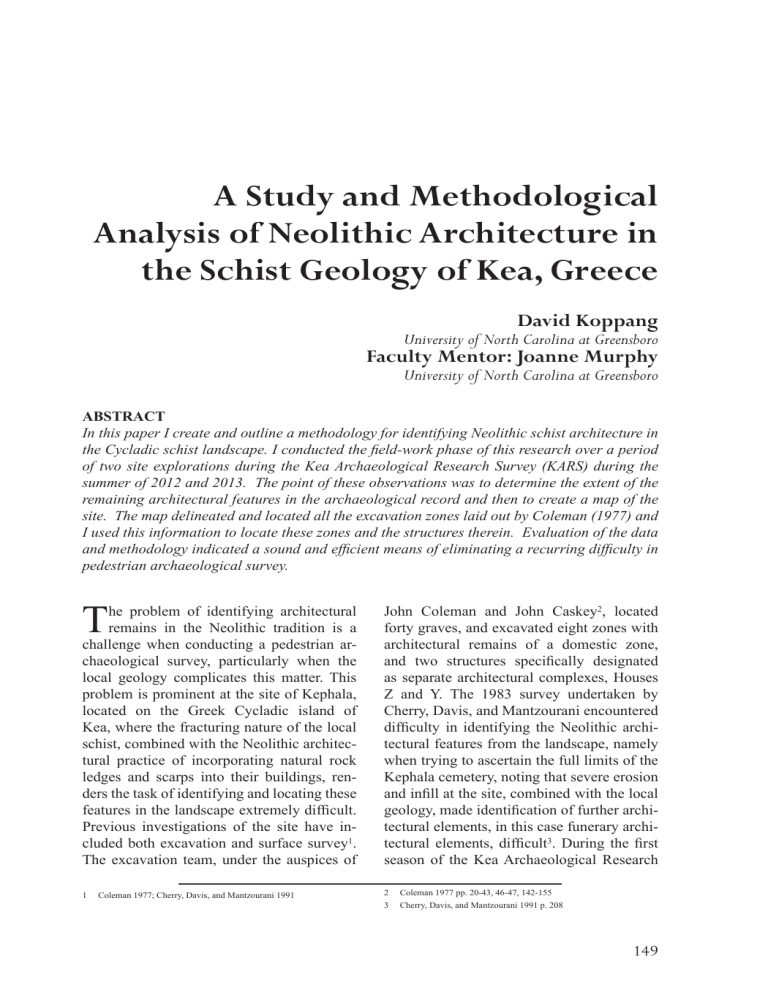
A Study and Methodological
Analysis of Neolithic Architecture in the Schist Geology of Kea, Greece
David Koppang
University of North Carolina at Greensboro
Faculty Mentor: Joanne Murphy
University of North Carolina at Greensboro
ABSTRACT
In this paper I create and outline a methodology for identifying Neolithic schist architecture in the Cycladic schist landscape. I conducted the field-work phase of this research over a period of two site explorations during the Kea Archaeological Research Survey (KARS) during the summer of 2012 and 2013. The point of these observations was to determine the extent of the remaining architectural features in the archaeological record and then to create a map of the site. The map delineated and located all the excavation zones laid out by Coleman (1977) and
I used this information to locate these zones and the structures therein. Evaluation of the data and methodology indicated a sound and efficient means of eliminating a recurring difficulty in pedestrian archaeological survey.
T he problem of identifying architectural remains in the Neolithic tradition is a challenge when conducting a pedestrian archaeological survey, particularly when the local geology complicates this matter. This problem is prominent at the site of Kephala, located on the Greek Cycladic island of
Kea, where the fracturing nature of the local schist, combined with the Neolithic architectural practice of incorporating natural rock ledges and scarps into their buildings, renders the task of identifying and locating these features in the landscape extremely difficult.
Previous investigations of the site have included both excavation and surface survey 1 .
The excavation team, under the auspices of
John Coleman and John Caskey 2 , located forty graves, and excavated eight zones with architectural remains of a domestic zone, and two structures specifically designated as separate architectural complexes, Houses
Z and Y. The 1983 survey undertaken by
Cherry, Davis, and Mantzourani encountered difficulty in identifying the Neolithic architectural features from the landscape, namely when trying to ascertain the full limits of the
Kephala cemetery, noting that severe erosion and infill at the site, combined with the local geology, made identification of further architectural elements, in this case funerary architectural elements, difficult 3 . During the first season of the Kea Archaeological Research
1 Coleman 1977; Cherry, Davis, and Mantzourani 1991
2 Coleman 1977 pp. 20-43, 46-47, 142-155
3 Cherry, Davis, and Mantzourani 1991 p. 208
149
Explorations | Social Sciences
Survey (hereafter referred to as KARS) an intensive gridded survey collection was conducted on this site, during which the problematic nature of identifying architectural elements was again noted. The survey results in this matter proved to be inconclusive, and the 1977 Coleman findings 4 remain thus unchallenged in this regard.The goal I am pursuing in this paper is to create and outline a methodology for identifying Neolithic schist architecture in the Cycladic schist landscape.
In the course of this paper I will outline what is to be accomplished by the creation of this methodology and its role in pedestrian archaeological survey as a means of alleviating the difficulties in this arena. To illustrate both the need for a methodology and how it will benefit archaeological research in the region
I will explain the nature of the problem presented by the native geology and architectural tradition. From there I will present my methods and their application in the field, and will then present an evaluation of the data gathered from the Kephala investigations and the conclusions that can be drawn to ameliorate the task of discerning Neolithic architectural elements in a Cycladic schist geomorph.
Objective
The primary objective of this research project was to establish a method for distinguishing Neolithic architectural elements, which I define in my research as any anthropogenic alteration of the landscape for the purposes of construction and any human made structures and structural elements, from naturally occurring changes or features within the schist geology of the island of Kea. While the research conducted deals specifically with the island of Kea, the geology of the Cyclades is such that methodologies established on Kea can, within reason, be transposed to other Cycladic landscapes.
The types of site targeted by the methodology under development are semi-exposed architectural sites near the surface, where the remains are visible for analysis, as this is a survey-based methodology. As Kephala is both partially exposed and a previously excavated Neolithic architectural site, it proved to be an ideal testing ground for the development of an architectural identification methodology. The fact that the site was previously excavated presented a unique challenge, in that questions of the efficacy of the resulting methodology could be raised, for how can one test an identification methodology on a pre-excavated site? The alternative, finding a new Neolithic architectural site, however, was neither practical nor feasible.
At any rate, the concerns raised by the use of
Kephala are addressed in the first phase of investigation.To understand the gravity of this problem, one must first become acquainted with both the nature of Cycladic Neolithic architecture, and the schist geomorph of
Kea. The island of Kea is located in the Attic
Cycladic Crystalline Complex, in the portion known as the Cycladic Blueschist Unit
(CBU). The CBU covers the southern tips of
Attica (Lavrion) and Euboea (Karistos), as well as the islands of Kea, Kythnos, Sifnos,
Ios, Delos, Naxos, Andros, Sikinos, Tinos,
Antiparos, Serifos, and Tinos 5 . The geological unit is, as the name would suggest, defined by the predominance of schist as the primary bedrock. This is, however, not the only rock present, as is made apparent by the presence of the large limestone outcrop at the site of Paouras on the northern shore of Kea.
Explanation of Problem
The predominant form of schist present on
Kea is mica-schist, so named for the presence of the mineral mica within the structure of the schist. The presence of mica is what gives the schist its signature cleaving behavior, wherein the schist breaks along planes established by the presence and positioning of the mica crystal flakes within the layers which comprise the schist 6 . These fractures, or cleavage, are largely tabular in
4 Coleman 1977 5 Bröcker and Pidgeon, 2007, Higgins and Higgins, 1996
6 Higgins and Higgins 1996
150
David Koppang nature, resulting in the creation of slabs of schist which can be of regular or irregular geometric shape (here regular is defined as clearly identifiable rectangular forms). The
Neolithic builders working at Kephala would have found this phenomena to be very much to their advantage, and would have likely exploited this in the construction of their dwellings and tombs. The problem presented here is that owing to the natural geometric cleavage pattern of the local schist, differentiating between naturally cloven schist, and schist that has been cloven and placed by human activity, is a rather problematic task. Short of encountering an intact wall foundation, it proves rather difficult to determine what is the exposed top of a wall unit, and what is a semi-exposed schist outcrop that has been cloven by natural forces so as to appear as a line of schist masonry. The matter is further complicated by the fact that the masonry at the site of Kephala does not appear to have been dressed in any fashion, aside from possibly reshaping some of the more irregular blocks. That said, even this is not readily distinguishable from the natural cleaving of the schist. The following figures illustrate the pertinent issues associated with the fracture patterns of schist.
Figure 1 demonstrates how even when
Figure 2 A naturally cloven Kean schist slab. Note the regularity with which it has been cloven from the outcrop and the evenness of the break. (Photo by author) cloven by natural forces, schist will break in a reasonably uniform and slab-like formation, separating both perpendicularly and parallel to the main outcrop, illustrating the tendency of the schist to cleave in a planar formation.
This is due to the presence of mica within the crystalline structure of schist. It should be noted that though the example in Figure
1 was found in a natural setting, it is by no means definitively indicative of all patterns of schist fracture, and in many instances of schist architecture the edges of the slabs vary in degrees of roughness, from mildly rough to quite jagged in appearance and touch.
Figure 2 illustrates the fairly smooth quality of a natural cleaving. As seen in the figure, schist breaks along relatively straight lines, much like worked stone, which is illustrated in Figure 3. The slabs in Figure 3 bear a striking resemblance to the naturally cloven slab in Figures 1 and 2.
Figure 1 A Kean schist slab naturally broken from an exposed outcrop. Note the regularity of the slab geometry and the clean lines of the break. (Photo by author)
Figure 3 A schist wall at Kephala. Note the irregularity in size, as well as the similarities between the slab in Figures 1 and 2 and the slabs composing the wall. Also of note is the presence of marble and limestone in the wall construction, as well as the color variations in the schist. (Photo by author)
151
Explorations | Social Sciences
These figures illustrate the fact that, at least where the Kean Neolithic architectural practice is concerned, there appears to be little to no difference between schist that has broken away naturally and that which has been extracted from the landscape by the builders of
Kephala. This ambiguity continues into the modern period, where in the course of my field research I noted that the local farmers construct their pens and retaining walls using the same methods, and like the inhabitants of Kephala do not appear to dress their masonry.
7 These walls vary in terms of energy expended, but consistently show the hallmarks of scavenged masonry, namely the lack of dressing and the noted absence of anything that could be definitively described as a quarry. This adds another dimension to the complication of identifying architecture in the landscape as there appears to be no evidence that the schist is worked.
One avenue that I had considered in the course of my research was the weathering rate of the schist, or rather to look for differences in weathering between potentially worked schist and the schist still resting in situ. Such investigations are, unfortunately, not wholly viable options. The reality is that the schist in the exposed masonry at Kephala, and that which has broken naturally from the bedrock, namely from the various exposed outcrops and ledges, has been exposed to the elements since the formation of the island itself. Obviously material below the surface will weather at a lesser rate, however the focus of this methodological investigation is on sites that are exposed on the surface, but rendered ambiguous by architectural tradition and landscape. A stone protruding from the ground and a stone lodged in a wall will experience the same exposure to the elements and thus display a similar weathering pattern.
It should be noted again that there was nothing in the literature or material to suggest that building material was extracted from beneath the soil level, therefore it is only these outcrops and cliff faces with which this research
7 For a fuller discussion of modern Kean architectural practice see the
chapters in Cherry, Davis, and Mantzourani 1991 pp. 351-454 is concerned. This is not to say that weathering analysis should be totally discarded, but rather that in this particular scenario it would be of little use. As Coleman 8 notes in his publication on the excavations at Kephala, the site as a whole is in a poor state of preservation, with much of the extant architectural remains showing signs of extensive wear from the local environment and gravity. Weathering analysis could potentially be applied to investigation of hypothetical schist quarrying sites, here understood to be surface extraction sites, as opposed to traditional methods of quarrying which dig below the surface and are highly intensive and invasive operations. A potential quarry site would be indicated by a decisive difference in the weathering of the schist, as the schist exposed by quarrying activities would not have been exposed for the same duration as the surface schist. Weathering in rocks can be detected by splitting the rock in half, looking for “weathering rinds”, a phenomena caused by changes in the structural integrity and appearance of the rock as a result of weathering, and which appears as a noticeable ringlike surface layer. In this scenario mechanical weathering tests can be conducted with metal probes to test the strength and integrity of the rock, and from there a numeric scale can be developed based on observations from this testing, as well as outward appearance of the rock 9 . Given that the majority of the schist appears to have been scavenged or pried from crumbling outcrops, however, the existence of dedicated quarrying sites is up for debate. At any rate, processes such as this, or cosmogenic ray analysis, which would best definitively date the rock, are prohibitively expensive in terms of energy and cost for what is being analyzed.
Methodology
I conducted the field-work phase of this research over a period of two site explorations during the Kea Archaeological Research
Survey (KARS) during the summer of 2012
8 Coleman 1977 p. 2
9 Goudie 1981 pp.152-153
152
David Koppang
Figure 4 A general plan of Kephala (Coleman 1977) and 2013. The point of these observations was to determine first the extent of the remaining architectural features in the archaeological record. Because the site of Kephala had last been excavated in the 1970’s, with no documented attempts at further conservation since that time, there were serious questions about the level of preservation at the site and if it would be possible to identify the site’s various elements and structures.
During the first excavations 40 years ago, the site of Kephala was determined to be in a relatively poor state of overall preservation 10 and during KARS operations in 2012, which consisted of an intensive, surface, survey collection and description of the cultural remains, as well as my own investigations, the site showed signs of collapse and refilling of the excavation zones. Knowing how poorly preserved the site was, I developed a methodology that would allow me to differentiate between unworked and worked schist slabs and to ascertain which were more likely to have been incorporated into structures.
Phase One of the investigation was to conduct an intensive architecturally focused survey on the site without the assistance of maps or research aids. By proceeding without these resources, an unbiased analysis was made possible. The main purpose of the Phase
One operation was to determine what would be immediately architecturally identifiable from the landscape of the site, as well as how the local geomorph impacted what could be seen. As this is a survey oriented methodology, the primary focus and research methods will heavily involve the human eye, namely what is visible to a field observer and how to aid that observer in the interpretation of the material data they are viewing in the field. In the 1983 survey, the problem of discrepancies in survey walker observation skills was considered, but was not found to be of significant detriment, with Whitelaw noting in his chapter on the investigations of Kephala that it did not cause significant fluctuations in the data 11 . Obviously a more attentive walker will have an easier time of detecting the sometimes subtle differences that contrast
Neolithic schist architecture from the native geology; however, the methodology I developed in my research is primarily focused on the field walker whose powers of observation fall in the average skill level. What is meant
10 Coleman 1977 p. 2 11 Cherry, Davis, and Mantzourani 1991 p. 202
153
Explorations | Social Sciences here is that such a walker can easily discern surface artifacts such as chipped stone and pottery, but may experience significant difficulty in separating Neolithic schist architecture from the surrounding schist geology, as was the case during the intensive grid pickup during the 2012 season, where many of the survey walkers were students experiencing archaeological material in its raw native context for the first time. It is important to note, however, that though the problem was highlighted during this season of the KARS endeavor, the problem has manifested itself in earlier investigations, and is not unique to the nature of utilizing student field school researchers. The objective was to see what could be picked out of the landscape by an observer, and what could be firmly and readily identified as architecture. This initial unaided observation was important in that it would determine first of all what the baseline capacity for the detection of architectural elements in the Kean landscape is for the average survey walker, and secondly establish a comparison point for the data obtained in the second phase of research.
An important goal of Phase Two was to first create a map of the site, delineating and firmly locating all the excavation zones laid out by Coleman, which would then be used to locate these zones and the structures therein.
By surveying the site a second time and focusing on the excavation zones, the observations made in the Phase One operation could be either verified or refuted. Phase Two of research made extensive use of the free Google
Earth application and the Coleman publication 12 . These diagrams were extracted into
GIMP (Gnu Image Manipulation Program), a freeware image editing and manipulation program, and used as temporary guide layers in Google Earth to trace the overall layout of the site as dictated by Coleman’s maps. This was done to have a properly oriented frame for the second step, which was to trace the locations of the excavation zones, and from there to trace the individual structural layout
12 Coleman 1977 of the architectural remains documented by
Coleman. By doing so a complete map of the site combining both the structures and excavation zones with satellite imagery was created. The reasons for the creation of this map were largely those of accuracy in terms of identification, as well as to contextualize any potentially new discoveries in the landscape of Kephala.
After mapping the site and the architectural features therein, I proceeded to the site to begin examining the excavation zones themselves. The location of these was now made clear, allowing for a comparison of observation of these zones pre, and post knowledge.
By examining the zones in the wake of the
Phase One operation, vital questions could be asked: What was still not being seen? What had been seen during the secondary runs that had not been seen in the Phase One investigation? Why had the material seen during the secondary runs not been seen during the
Phase One investigation? These questions also led into inquiries into the nature of the architecture at Kephala. What do all these architectural elements have in common to distinguish themselves from the local rock?
How have the natural forces of time, nature, and the landscape impacted the remains? Also of importance is the question of how these architectural elements correlate to the ceramic and lithic densities observed in the course of investigations of the site. To be sure, the volume of questions raised did indeed appear quite daunting. The methodological model was put in place to ensure that sufficient data could be generated to answer these questions, or at the very least begin asking the proper questions to tackle the main questions.
Observations and Conclusions
The Phase One investigation of the site was concluded in fairly short order. The site of Kephala measures approximately 275 meters in length from east to west, and, at its widest, from north to south approximately
150 meters in width. The primary target area
154
was the south slope, where the Coleman excavation zones were located, and where the site was most accessible for large scale exploration. Owing to the highly interpretive nature of the project I did most of the walking myself, mainly for the sake of consistency, although student observers were included for purposes of instruction and observation.
The Phase One operation took place at approximately 12:00 PM Hellenic time on June
23, 2010, and continued until approximately
3:30 PM. During that time the entirety of the south slope was examined. In this initial investigation identifications were extremely tentative. The area of Zone G from the
Coleman excavation 13 was located; however, this was one of the more prominent features of the site, comprised of a wall situated on a rock ledge above the spine of the Kephala isthmus. As such this identification must be taken for what it is, the observance of a salient archaeological element, and therefore is not a major accomplishment in terms of observation. Beyond this first zone identification there was little else which was positively identifiable, as was suspected.
After the initial walking of the south slope, an attempt was made to locate a questionable feature from the first year of the KARS project; a schist slab embedded in the hillside at a roughly 90 degree angle. While this feature has been documented in the prior year’s research notes, as well as photographed, in light of both its qualities and location, this particular feature was specifically targeted as being relevant to this research endeavor. It is unfortunate then that during the course of the blind run, and subsequent runs, the feature was unable to be relocated. It is my opinion that this feature, having been partially covered by a patch of vegetation overgrowth when it was first noted, may have been enveloped by said overgrowth, or else the same forces which have served to deteriorate the site have perhaps carried it away, as its position did indeed seem somewhat precarious.
In the course of the Phase Two operations
13 Coleman 1977 Plate 6
David Koppang on the site (June 30th and July 7th respectively), Excavation Zones D, L, and F were located and the surrounding area of these zones examined as well. These investigations proceeded in a straightforward manner owing to the utilization of the mapping data generated for this project, and the excavation zones were located quickly and efficiently. Because map data were utilized, the Phase Two operations on the site were targeted to specific areas. The first Phase Two operation focused on the area around Zone D, as research conducted after the Phase One operation indicated a heavy architectural presence in that particular zone.
14 Because of the density of architectural material located in this zone by
Coleman, it was decided that this would be where the primary observations on the nature of Kean Neolithic Schist architecture would be made. Upon approaching Zone D, it was readily apparent why it had escaped notice during the blind run. While fairly exposed, the structure was very much integrated into the landscape, and partially obscured by vegetation. In what is posited to be the interior of the structure, a concentrated growth of ballota acetabulosa sits atop a wall which, at first glance appears to be a naturally fractured schist rock. Its positioning relative to the readily distinguished architectural elements, however, suggested otherwise, and this was confirmed by consultation with both the map and the Kephala publication.
This brings us to item number one in the methodological corollary which has resulted thus far: architectural elements can potentially be identified by proximity to other architectural elements. Not just in Zone D, but across the site’s excavation zones, it was found that in the majority of cases where a suspect rock formation was observed in close proximity to readily apparent architectural remains, said formation was found to have been a plotted architectural feature in the Coleman report.
Again, this emphasizes the importance of the
Phase One operation, as well as the decision to use a previously identified Neolithic site.
14 Coleman 1977 Plate 4
155
Explorations | Social Sciences
Specific example aside, several recurring trends were observed in the architectural data of Kephala. One overarching theme throughout the observations made of the architecture at Kephala is the use of thick slabs of schist and occasionally limestone, although this was observed only in limited quantities, and is confirmed by Coleman 15 . Contrary to other examples of Neolithic architecture, particularly on the mainland, there appears to be no evidence of the use of mudbrick, and as such is must be assumed that the entirety of the
Kephalan structures was schist drystone masonry, with the roofs being either schist slabs or less durable material such as clay, reeds, or timber. The slabs in the retaining walls in particular are of a thicker, sturdier order than those used to cover a wall which is cut into the hillside, such as at Zone L. Zone L is interesting in that in addition to being cut into the hillside, it also makes use of a limestone slab approximately 40-43 cm. long set into a niche located in the center of the north wall of the structure.
This item, in addition to the observation that multiple varieties of schist beyond the local green are present in abundance, suggests that perhaps the Kephalans looked to sources outside their locality for building materials. This would not be surprising as it would appear that constant exposure to salt water does not have a beneficial effect on the structural integrity of schist, although further research would be needed to establish this as a genuine absolute. Therefore architectural elements can potentially be distinguished by marked difference in the stone from the local geology, even if the difference is more superficial in nature. The reasoning for this could be superiority of strength, perhaps a desire not to gouge out their own land, which might be better suited to other activities, or perhaps as simple as aesthetic taste and prestige. For
Kephala, I would venture to say that it was a matter of integrity of materials, owing to the observed, and very marked, fragility of the local schist, which I would again attribute to
15 Coleman 1977
16 Coleman 1977 pp/ 1-3 the corrosive action of salt water from waves and particles in the air.
With the statement of this corollary, the question remains, “Does it work?” For the question of efficacy I can only point to a rather small discovery, but a discovery nonetheless. In the space between Zones L and F, a series of stones was observed running in a line from east to west, towards Zone F. Upon further examination, these stones were found to connect to exposed patches of walls, and more importantly that these stones were uniform in their path of “travel” so-to-speak, and were markedly different from the local green schist. Initial notions that this might have been a sheep wall were dispelled when it was pointed out that such structures, once land is purchased for clearance and excavation, are removed. It also bears mentioning that the wall in question connects two archaeologically validated structures. It is my opinion therefore, that this wall is perhaps a Neolithic retaining wall, given that it abuts the slope of the hill and follows its contours. In his opening description of the site of Kephala,
Coleman notes that it appears that much of the terracing (which Coleman posits to have been the means by which the settlement was situated on the slopes of the headland) which supported the settlement appears to have been swept away by the gravity and the forces of erosion 16 , leading me to suspect that this wall may be the remnants of such terracing.
To conclude, though the Kean/Cycladic landscape presents unique challenges to archaeological investigation, when approached and probed methodically, solutions can be found. It is my profound hope that the efforts presented here are of use to those who will follow behind me. Survey archaeology presents its own unique challenges, of which those addressed in this research are a part.
Through thorough analysis of the Neolithic site of Kephala and consultation of prior investigations, the framework of a methodology was created. This was then further developed through research and exploration of
156
David Koppang both the nature of the Cycladic schist landscape, in particular as it presents on Kea, and the nature of the Neolithic builders at
Kephala, and thereby ostensibly across Kea.
The methodology I have delineated here represents what my research has revealed to be a sound and efficient means of eliminating a recurring difficulty in pedestrian archaeological survey.
Acknowledgements
I would like to close this report on my research findings first and foremost with a statement of thanks for the assistance rendered to me by the staff and students of the
Kea Archaeological Research Survey, in particular the tireless support of Dr. Joanne
Murphy of the University of North Carolina at Greensboro, Giannakis Timotheou of the
Greek Department of Antiquities and Ciarán
Murphy, whose dedicated support of both my research and the KARS project is worthy of great praise, Dora Lambert, whose assistance with the mapping portion of my research is greatly appreciated, Margarita Nazou, whose expertise on the Neolithic period and Kephala was of considerable help, and Caolán Mac
An Aircinn of Trinity College Dublin and
Ashley Rutkoski of the University of Akron, whose sincere interest in, and participation in my research cannot be appreciated enough.
Additional thanks must be expressed to the staff of the Kea Archaeological Research
Survey (KARS). My success in this project is thanks in no small part to their efforts and support.
157
Explorations | Social Sciences
Works Cited
Bröcker, M. and R.T. Pidgeon.
2007 Protolith ages of meta-igneous and meta-tuffaceous rocks from the Cycladic blueschist unit, Greece: results of a reconnaissance U-Pb zircon study. Journal of
Geology, 115, 83-98.
Burn, A.R. and Mary Burn
1980 The Living Past of Greece. London. Herbert Press Limited
Cherry, John, Jack Davis, and Eleni Mantzourani
1991 Landscape Archaeology as Long-Term History: Northern Keos in the Cycladic
Islands From Earliest Settlement Until Modern Times. Los Angeles. UCLA Institute of Archaeology
Coleman, John. E.
1977 Kephala: A Neolithic Settlement and Cemetery Vol. 1. ASCA
Goudie, Andrew, with Malcolm Anderson, Tim Burt, John Lewin, Keith Richards, Brian
Whalley, and Peter Worsley
1981 Geomorphological Techniques. London. George Allen & Unwin
Higgins, Michael Denis and Reynold Higgins
1996 Geological Companion to Greece and the Aegean. Ithaca. Cornell University
Press
158
